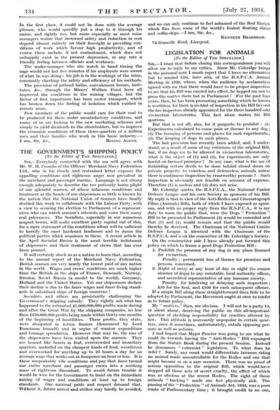SPEEDING UP IN THE MINES [To the Editor of THE
SPECTATOR.] SIR,—Mr. Brierley's article in your issue of July 6th gives a hopelessly distorted view of the conditions in the coal-mining industry. That the industry is depressed, pays wages lower than the sheltered trades and yields meagre profits on the capital employed, is so well known that it needs no amplifica- tion. At the same time it cannot be too well known that the industry has made great efforts to reduce costs and improve
conditions.
Mr. Johr. Brass (President), at the annual dinner of the Institution of Mining Engineers on Thursday, July 12th, 1934, gave the following statistics :
" In the last quarter of the year 1925, the output of saleable coal per coal-face worker was 46 tons ; in the corresponding quarter of 1933 it was 58 tons, an increase of 21 per cent. In the same period, the output of saleable coal per person employed in or about a mine increased by 27 per cent., from 18.3 to 23 tons, and the cost of production was reduced from 17s. 41d. to 12s. 110. per ton, a reduction of 34 per cent."
These are remarkable results and reflect great credit not only on the technical staff at the mines but also on the workmen who have made them possible. In the achieve- ment of these remarkable results the most important factor has been the mechanization of the mines. Coal previously cut by hand is now cut by machinery in an increasing quantity each year. Coal previously conveyed in tubs either by hand or by ponies is now being delivered to, the main arteries of the mine by conveyors. Concentration on the better seams where the geological difficulties are least has also helped the
output per person employed and decreased the cost.
What is the effect on the workman Y My own experience
in charge of from 3,000 to 4,000 men, where a complete change-over in methods of work has been carried through during the last seven or eight years, is that the most laborious part of the work has been cut out, and this in any industry is to the good ; but I am afraid that there is as usual in this mechanization an absence of that feeling of satisfaction which comes to the hand craftsman. The picture of the miner being continually bullied is one which is often used for
propaganda purposes but one which is far from the truth.
In the first place, it could not be done with the average pitman, who would speedily put a stop to it through his union, and rightly too, but more especially as most mine managers realize that increased safety and reduction in cost depend almost entirely on their foresight in providing con- ditions of work which favour high productivity, and of course these include, if not contentment, which does not unhappily exist in the present depression, at any rate a friendly feeling between officials and workmen.
The under-manager who sits watch in hand timing the cage would not last five minutes if his employers were aware of what he was doing : his job is in the workings of the mine, constantly checking the safety and efficiency of his methods.
The provision of pithead baths, convalescent homes, insti- tutes, &c., through the Miners' Welfare Fund have all improved the conditions in the mining villages, but the factor of first importance has been motor transport, which has broken down the feeling of isolation which existed in remote areas. • Few members of the public would care for their coal to be produced for them under unsatisfactory conditions, and many of us are looking to the new marketing schemes not simply to yield dividends to the shareholders, but to improve the economic conditions of these three-quarters of a million men and their families who work in this basic industry.—



































 Previous page
Previous page